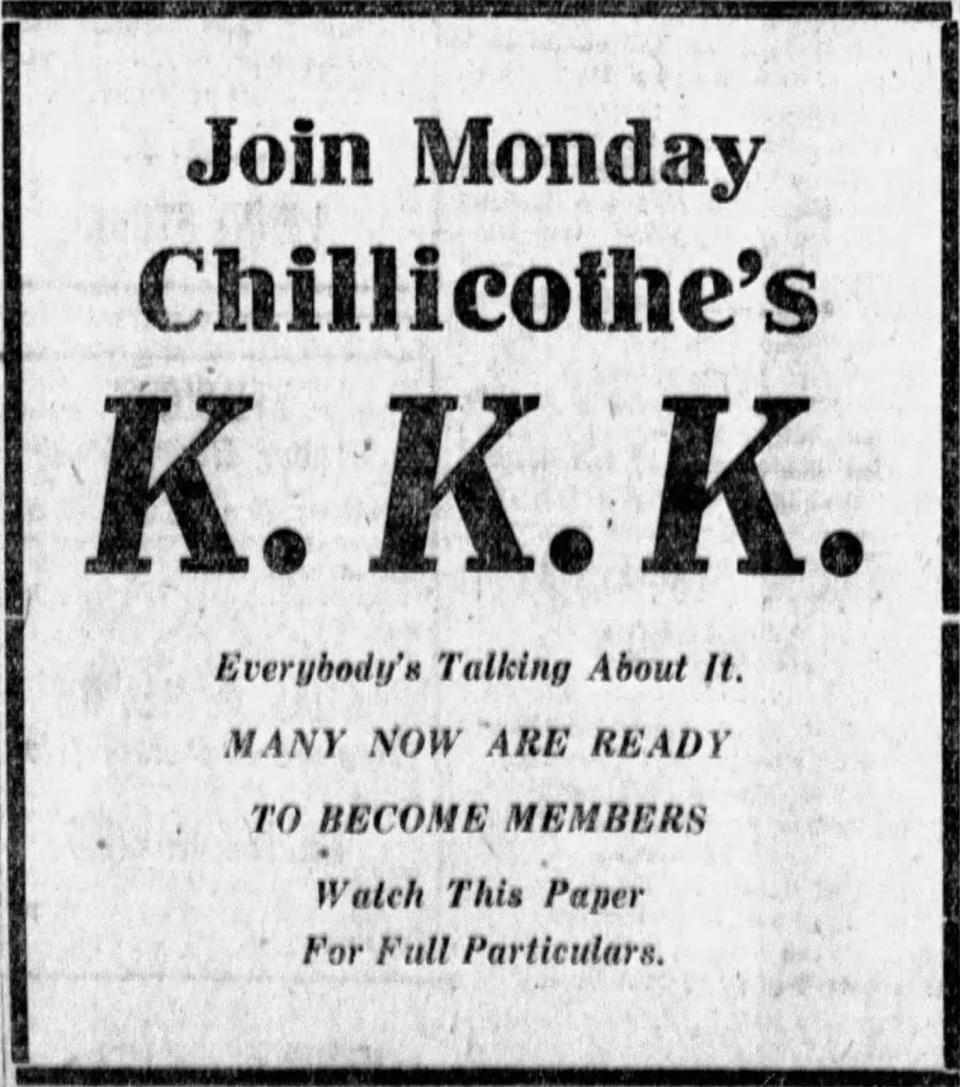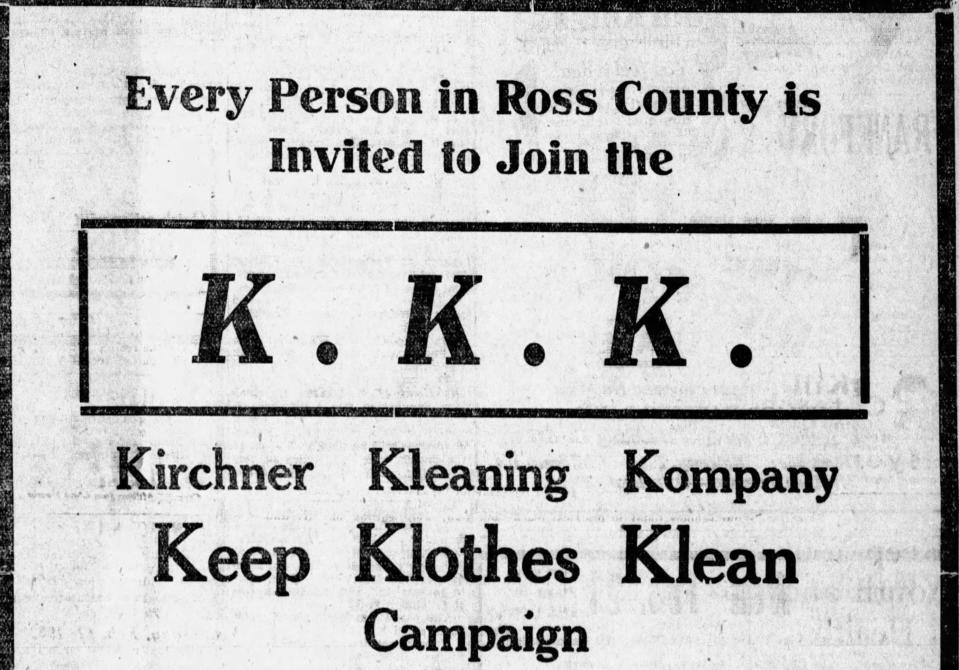Looking Back: When the Klan came to Chillicothe
It was Monday, June 25, 1923, and the moon shined brightly in a dark sky above Chillicothe on a perfect summer evening. But this was no ordinary evening.
A long line of autos rattled down East Main Street, one vehicle after another slowly rolling to a stop alongside the curb and parking. It started out as a trickle. Then it became a steady stream.
Eventually about 800 vehicles lined both sides of the street for as far as the eye could see, their headlights lighting up the night.

It wasn’t just cars, though. Hundreds of pedestrians crammed the sidewalks, entire families with children, young couples, groups of men and young boys all heading in the same direction.
By 8:30, an estimated 5,000 Chillicothians jammed Main Street.
At precisely 8:35, all eyes turned toward an open field where dozens of mysterious-looking hooded figures began gathering and forming a long line that stretched into the darkness. The line of white-robed men faced the crowd, apparently there to keep the spectators back.
Suddenly, directly behind the wall of men, three K’s burst into flames, casting an orange glow over the field.A hush fell as the spectators gazed in awe, but just as suddenly a huge cross also burst into flames, revealing a large circle of hooded men. Inside the circle nervously stood Chillicothe’s newest Ku Klux Klan candidates.
Several Klan officers stepped into the circle and the candidates immediately knelt. As if on cue, the white-robed men, about 300 in all, knelt as well.

Next, in a ritual that the Gazette later described as resembling a religious gathering, the candidates reverently pledged to uphold the principles of the Klan, including the Christian religion (Protestantism), the American flag, the purity of women, white supremacy and 100 percent Americanism. The KKK had arrived in Chillicothe.It wasn’t just Ross County; The Ku Klux Klan was having a rebirth in the 1920s, with eventually about 4 million Americans wearing the sheets and cone-shaped hats of the group.
This KKK, however, was different from the one formed after the Civil War in the 1860s. The original Klan was located in the South and mostly made up of Confederate veterans. It was a terrorist organization determined to cower newly freed blacks from exercising their full citizenship rights, but it had mostly faded away by the early 1870s.
The Ku Klux Klan of the 1920s, on the other hand, spread like wildfire all across the country and was arguably most active in three states in America’s heartland: Illinois, Indiana and Ohio.
This new Klan still hated Blacks and Jews, of course, but another main target, at least in the Midwest, were Catholics.
America had just experienced the largest influx of immigrants in its history and these new arrivals were overwhelmingly from Southern and Eastern Europe. Many were predominantly Catholics, especially Italians.Anti-Catholicism was nothing new in America, but the flood of newcomers especially worried Protestant Christians because they believed Catholics were loyal to a foreign church, a foreign pope and threatening traditional American culture by forming their own schools.

This new Ku Klux Klan also had a much different membership than the original Klan.
Members were mostly upstanding citizens of the community: merchants, professionals, Kiwanis and Elks members, church-going people. They were not rubes, but mainstream residents and proud to join the group.Just four months before the Main Street ceremony, however, the idea of the Klan spreading in large numbers in Chillicothe was unthinkable and not being taken very seriously.
This ad, for example, appeared in the Feb 17, edition of the Gazette.
“Join Monday Chillicothe’s K.K.K. Everybody’s talking about it. MANY NOW ARE READY TO BECOME MEMBERS. Watch this paper for full particulars.”
Newspapers undoubtedly flew off the shelves on Monday, readers leafing through the pages to find out what the divisive group was up to. And there it was, an even larger ad filling nearly half a page.
“Every Person in Ross County is Invited to Join the K.K.K. Kirchner Kleaning Kompany. Keep Klothes Klean Campaign. It cost you nothing to join the K.K.K.”
Unbelievably, it was an advertising gimmick to promote the services of the Kirchner Dry Cleaning Company, located on High Street. The Klan was still a joking matter in Chillicothe then, but no more.
The Klan had been busy organizing in Ross County in the months before the crowded initiation ceremony, and there were rumors that it had successfully recruited 300 members, but the organization had been ordered to vacate its local headquarters and had been relatively quiet in recent weeks.
It was true that a Klan official from Columbus had been spotted in the city on several occasions, but the very public initiation ceremony and rapid growth of the group must have surprised many Chillicothians.
And after responsible citizens of the community began embracing the Klan, especially church-going men and women, it increasingly became acceptable to join the group. Actually, there suddenly must have been peer pressure to listen anew to what the Klan had to say.
Even the Gazette who earlier had editorialized against the Klan, wrote the following about the Main Street initiation ceremony.
“Words can hardly do justice to the beautiful and impressive scene enacted Monday evening when the knights of the Ku Klux Klan initiated a large class of candidates.”
The paper also heaped praise on the “orderly character” of the residents who stood quietly on the street and witnessed the ceremony.
“The discipline that was maintained throughout the entire affair was aided greatly by the general absence in the crowd of any desire either to intrude or to disturb.”
After the ceremony, the crowd of 5,000 returned to their homes quietly, likely among them future members of Chillicothe’s KKK.
This article originally appeared on Chillicothe Gazette: Looking Back: When the Klan came to Chillicothe

